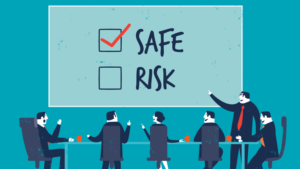May Safety Tip
Six Steps to Completing an Effective Job Safety Analysis
For 27 years, the Bureau of Labor Statistics has reported on workplace injuries across the United States. During that time, both the number of cases and the rate per 100 workers has steadily decreased. In 2018, they reported 2.8 million nonfatal workplace injuries and illnesses.
While these decreasing numbers are encouraging, occupational health and safety (OHS) professionals must constantly consider ways to improve. Currently, much of OHS is about responding to workplace accidents. While this is still extremely important, the field is changing and is becoming more about prevention and hazard identification.
Safety experts have begun to focus on educating employees and identifying potential issues rather than on what is essentially damage control. Without a solid understanding of the hazards and risks your employees face with the tasks they accomplish each day, it’s impossible to keep them safe. The hope is that taking a prevention-based approach and trying to stop an accident from ever happening will help companies save the time and money that comes along with mitigating the effects of workplace accidents.
Effective risk management starts with identifying and addressing hazards before incidents occur. While most safety professionals understand that a thorough job safety analysis (JSA) is a trusted process for evaluating workplace hazards, the challenges of carrying them out often derail companies from completing them and revisiting or updating them as needed to remain effective.
Here are the critical steps to completing an effective JSA.
Step One: Select Which Job to Analyze
To start the JSA process, choose the jobs or tasks that need to be evaluated. Selecting the jobs to be analyzed can be a vital consideration when employers have limited time and resources to analyze all of the various jobs associated with their operations. A good best practice is to prioritize the jobs to be analyzed. This way, even if analysis of all jobs does not occur, it will ensure that the most critical jobs are examined first.
Use the following criteria to prioritize what jobs you will analyze:
- jobs with the highest injury or illness rates,
- jobs with the highest potential for injury or illness,
- jobs in which one simple human error could lead to a severe accident or injury,
- new jobs, processes or ones that have undergone changes in processes or procedures,
- jobs complex enough to require written instructions and
- infrequently performed jobs: workers may be at greater risk when undertaking non-routine jobs.
Regardless of the jobs or tasks selected for evaluation, it’s critical to have accurate information about the hazards that workers performing them face.
Step Two: Job Task Breakdown
To perform a thorough and accurate JSA, each job must be broken down into a defined sequence of individual tasks. It’s important to avoid defining individual job tasks too narrowly or too broadly.
Generally speaking, a job should contain no more than ten individual tasks. If your JSA exceeds this number, consider separating the job into two or more separate phases. It also is vital to maintain the proper sequence of job tasks to ensure that during the hazard identification phase, hazards are addressed in the order they are encountered by employees.
Job task breakdown typically is accomplished through direct observation, with at least one safety contact or direct supervisor familiar with the job and recording the series of individual tasks as they are performed by an experienced employee. Observation of an experienced employee helps ensure that job tasks are performed in the proper sequence with a high level of precaution, helping to identify unforeseen hazards more easily. This also helps ensure that all tasks, even frequently missed steps like set-up and clean-up, are being reviewed as well
Once the observation is complete, participants should convene to review the findings and ensure that all steps sufficiently were identified.
Step Three: Identifying Hazards
Hazards should be identified immediately after the observation of job tasks while the sequence of job tasks and potential hazards still is fresh in the minds of all participants. If one or more job tasks need to be repeated, it should be done immediately, if possible.
A number of questions should be asked to assess the potential hazards in performing individual job tasks. Proceed through the sequence of job tasks one at a time and answer questions such as:
- Are there any pinch points or potential for body parts to be caught between moving machinery or objects?
- Can the worker may harmful contact with moving objects?
Does the equipment, tools or machine in use present any potential hazards?
Is there a potential for slips, trips or falls? - Is there a risk of injury due to excessive strain from lifting, pushing or pulling?
Is there a risk of exposure to extreme heat or cold? - Is there a danger of falling objects?
- Is lighting a problem?
- Does the task expose employees to excessive noise or vibration?
- Is there potential for exposure to toxic/hazardous substances, harmful radiation or electrical hazards?
Employees performing the tasks for which the job safety analysis is being conducted should provide input and insight into the hazard identification process, and strive to consider every possible outcome in the performance of each task. Proper controls should then be developed to limit the potential for the job hazards to result in an environmental or safety incident.
Step Four: Develop Preventative Measures
The hierarchy of controls is a well-known and commonly-used tool for developing preventive measures for hazards associated with job tasks. The National Institute for Occupational Safety and Health lists the five controls, in order of effectiveness, with the following description:
Elimination– Physically remove the hazard
Substitution – Replace the hazard
Engineering controls – Isolate people from the hazard
Administration controls – Change the way people work
PPE – Protect the worker with personal protective equipment
Hazard elimination widely is considered to be the most effective, longest-term solution to improving job safety. However, it also often is the most difficult and expensive in the short term to implement. Administrative controls and PPE measures tend to be less expensive to implement initially, but often are less effective at controlling hazards and can be difficult to sustain in the long term.
Step Five: Document and Communicate Job Hazard Analysis Findings
After a JSA has been completed, the findings should be documented and made available to employees so that they are aware of the hazards associated with the jobs they will be performing, and know what preventive measures will help keep them safe. JSAs should be living documents that capture information about risks, document controls and inform the employees about both the hazards in their job tasks and the best means of avoiding them.
Employees need to know JSAs exist, and have quick and easy access to them. Furthermore, workers also need to be able to understand and act on them. It’s a matter of training and ensuring that the JSAs are easy to read and understand.
The importance of effective and well-documented training cannot be emphasized enough. In many situations following a serious accident, questions of liability hinge on the issue of whether training on the JSA was conducted, whether it adequately covered what needed to be covered, and whether the evidence sufficiently backs up your answers to these questions.
Step Six: Get Help (If Needed)
Even with the steps to completing a JSA broken down, the reality is that some employers just don’t feel like they have the time or resources to complete them for each job or task. Fortunately, today’s EHS software solutions help simplify the creation, management and implementation of JSAs.
A good electronic risk analysis program makes it easy to develop good assessments and track corrective actions, and when combined with an incident management software solution, you can oversee all aspects of incidents – from reporting to tracking of corrective actions. employees – even through the use of their mobile devices – giving them better access to hazard and preventive information so they can work safer and more efficiently.
Maintaining a good JSA program is an ongoing and evolving process. If a workplace injury occurs, a review of the relevant JSA should occur to see if it had a shortcoming that may have contributed to the incident. A good practice is to involve your workforce in a periodic review exercise for existing JSAs to make sure they still accurately capture the job tasks as performed today and address all associated risks.
Better insight into the hazards workers face with their jobs and tasks leads to more effective risk management. By facilitating communication, participation and engagement among everyone involved on the worksite, JSAs offer the opportunity to identify unforeseen hazards and increase support for a stronger, more inclusive safety culture.
https://www.ehs.harvard.edu/sites/default/files/job_safety_analysis_fact_sheet.pdf

